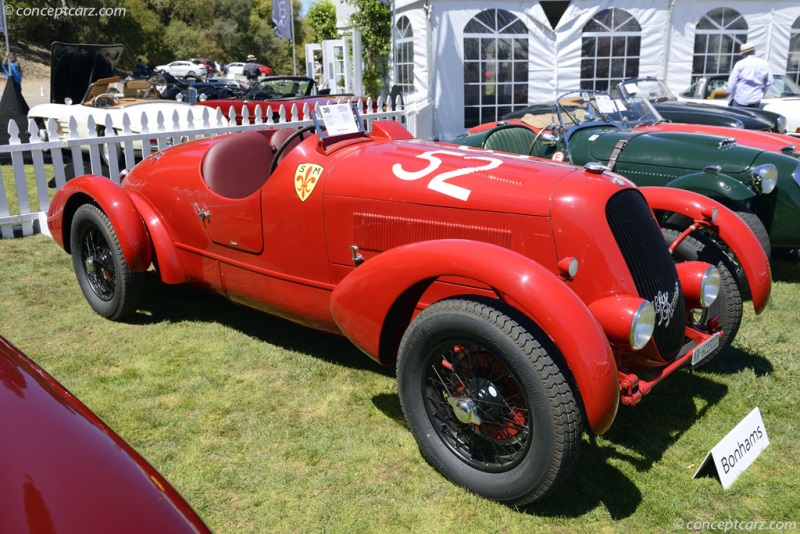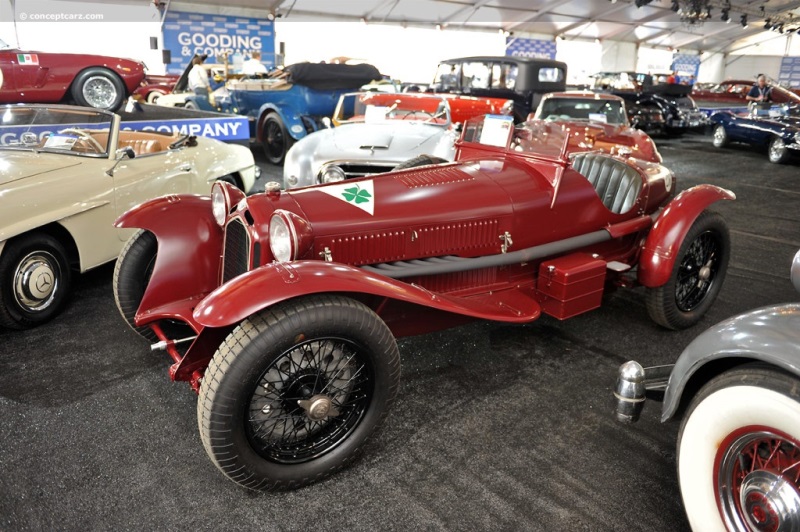History
The 2.3-liter version of Vittorio Jano's engine was a continuation of excellence and perfection. The 1500 was the first increment, and it truly created recognition for the Italian based manufacturer. The 1750 and 1900 soon followed, then came the 2300 which offered just over 70 horsepower initially. Its construction was very similar to its predecessors, utilizing two overhead camshafts actuating two valves for each cylinder. It was formed using a cast-iron block and light-alloy head and mated to a four-speed gearbox with drum brakes on all four corners.
The first car to house the 2300 engine was the 63 2300 which made its inaugural debut at the 1934 Milan Motorshow. The body was courtesy of Castagna in four-door saloon configuration. A short-wheelbase Gran Turismo version soon followed, as did a higher compression version of the engine offering nearly 100 horsepower. These sporty versions were called the Pescara model and only sixty examples would ever be produced. The long wheelbase versions were called the Turismo's, the shorter Gran Turismos were known as the Pescara's. Within a few years, they would simply be known as the SWB and LWB for 'short' and 'long' wheelbase respectively.
Time brings about improvement, and very little time transpired before a 'B' version was introduced. In 1935 the 6C 2300B was introduced which brought new changes to the suspension and chassis, and mild improvements to the already potent powerplant. The suspension was independent in both the front and rear with swing axles in the rear and wishbones in the front.
In 1937 a Pescara emerged from the Mille Miglia with a class victory; in its honor the Pescara's name was changed to MM.
Production of the 2300 continued until 1939 when it was replaced by the 6C 2500 which would remain in production, except during war time, until 1952.
By Daniel Vaughan | Dec 2010
The first car to house the 2300 engine was the 63 2300 which made its inaugural debut at the 1934 Milan Motorshow. The body was courtesy of Castagna in four-door saloon configuration. A short-wheelbase Gran Turismo version soon followed, as did a higher compression version of the engine offering nearly 100 horsepower. These sporty versions were called the Pescara model and only sixty examples would ever be produced. The long wheelbase versions were called the Turismo's, the shorter Gran Turismos were known as the Pescara's. Within a few years, they would simply be known as the SWB and LWB for 'short' and 'long' wheelbase respectively.
Time brings about improvement, and very little time transpired before a 'B' version was introduced. In 1935 the 6C 2300B was introduced which brought new changes to the suspension and chassis, and mild improvements to the already potent powerplant. The suspension was independent in both the front and rear with swing axles in the rear and wishbones in the front.
In 1937 a Pescara emerged from the Mille Miglia with a class victory; in its honor the Pescara's name was changed to MM.
Production of the 2300 continued until 1939 when it was replaced by the 6C 2500 which would remain in production, except during war time, until 1952.
By Daniel Vaughan | Dec 2010
The Alfa Romeo 6C 2500 was introduced near the end of the 1930's. The 6C name was derived from the engine size, an inline-six while the 2500 represented the engine's cubic-centimeter displacement size.
The engine was a version of Vittorio Jano designed a six-cylinder engine. The 6C was available in a plethora of body styles and wheelbases and was produced during two different times in history. Most of the coachwork was handled by Touring of Italy or by Pinin Farina. The body styles ranged from coupes and convertible to a four-seater salon. In 1939 Alfa Romeo introduced the SS version, a short-wheelbase model, dubbed 'SS' for Super Sport, that had a high-compression 6C engine rated at 105 horsepower. It was the top-of-the-line 6C model that married style and performance together to create the perfect road-going vehicle.
World War II had interrupted production for many automobile manufacturers. During this time many switched their efforts to support the war, such as building engines for marine and aircraft or by producing vehicles that were suitable for wartime. When Alfa Romeo resumed production, their vehicles were similar to those they had offered in 1939. The main difference was that Alfa Romeo now bodied the cars themselves rather than providing the rolling chassis for custom coachbuilders to body. The designs had become standard but they were still based on sketches and designs produced by coachbuilders such as Pinin Farina and Touring. Pinin Farina built exclusive bodies such as the Cabriolet. These vehicles were elegant and stylish and had a price tag that matched. Touring built the Coupes which became known as the Villa d'Este in 1949 after winning the famous Concours d'Elegance Villa d'Este. When outfitted with the Superleggera, meaning lightweight, bodies were capable of speeds in excess of 100 mph.
The engines were similar to the Jano designed six-cylinder power plant, capable of producing 110 horsepower. Independent suspension was installed to soften the ride while improving performance and handling characteristics. A four-speed manual transmission was similar to the one used prior to the onset of the war.
The history of the Alfa Romeo 6C 2500 automobiles are extensive. The various designs and body-styles matched with their mechanical capabilities make this one of the finest Alfa Romeos ever produced.
By Daniel Vaughan | Oct 2006
The engine was a version of Vittorio Jano designed a six-cylinder engine. The 6C was available in a plethora of body styles and wheelbases and was produced during two different times in history. Most of the coachwork was handled by Touring of Italy or by Pinin Farina. The body styles ranged from coupes and convertible to a four-seater salon. In 1939 Alfa Romeo introduced the SS version, a short-wheelbase model, dubbed 'SS' for Super Sport, that had a high-compression 6C engine rated at 105 horsepower. It was the top-of-the-line 6C model that married style and performance together to create the perfect road-going vehicle.
World War II had interrupted production for many automobile manufacturers. During this time many switched their efforts to support the war, such as building engines for marine and aircraft or by producing vehicles that were suitable for wartime. When Alfa Romeo resumed production, their vehicles were similar to those they had offered in 1939. The main difference was that Alfa Romeo now bodied the cars themselves rather than providing the rolling chassis for custom coachbuilders to body. The designs had become standard but they were still based on sketches and designs produced by coachbuilders such as Pinin Farina and Touring. Pinin Farina built exclusive bodies such as the Cabriolet. These vehicles were elegant and stylish and had a price tag that matched. Touring built the Coupes which became known as the Villa d'Este in 1949 after winning the famous Concours d'Elegance Villa d'Este. When outfitted with the Superleggera, meaning lightweight, bodies were capable of speeds in excess of 100 mph.
The engines were similar to the Jano designed six-cylinder power plant, capable of producing 110 horsepower. Independent suspension was installed to soften the ride while improving performance and handling characteristics. A four-speed manual transmission was similar to the one used prior to the onset of the war.
The history of the Alfa Romeo 6C 2500 automobiles are extensive. The various designs and body-styles matched with their mechanical capabilities make this one of the finest Alfa Romeos ever produced.
By Daniel Vaughan | Oct 2006
Alfa Romeo Monthly Sales Volume
March 2023
2,390
1934 Alfa Romeo 6C 2300 Vehicle Profiles
Recent Vehicle Additions
Related Automotive News

Curtain Falls On Record-Breaking Salon Privé Week
Top marques unveil exciting new models at Blenheim Palace
Ex-Nuvolari Alfa Romeo 8C 2300 crowned Best of Show in Concours dElégance presented by AXA
Evolution of the Supercar celebrated in Salon Privé Masters by Pirelli and Lockton
Classic %26 Su...

Ex-Scuderia Ferrari Alfa Romeo 8C 2300 Monza Spider By Zagato Scoops Best Of Show At Salon Privé
Alfa Romeo 8C 2300 Monza Spider by Zagato raced by Tazio Nuvolari wins top award
Leading designers present inaugural Churchill Cup to rare Lancia Astura
Duke of Marlborough selects his favourites on two wheels and four
Record entry for the UKs...

'Storie Alfa Romeo' Episode 2: Iconic 6C 1750 Foretells Future And Dominates Its Era
In the 1930s, the 6C 1750 possessed the unique ability to win both races and design awards
With outstanding power to weight ratio and perfect balance, the 6C 1750 launched technical traditions that continue today
The flying man from Mantua...

Italian Pre-and Post-War Marvels to star in Scottsdale
December 19th, 2019 – Los Angeles – An astounding selection of collectors automobiles has just been consigned to Bonhams popular Scottsdale Auction. From two sensational vintage Italian sports-racers, to the Philip Reed Collection of pre-war...

Alfa Romeo And FCA Heritage At The Mille Miglia 2017
The 35th historic re-enactment of the most famous road race of all time will take place from May 18 to 21.
Alfa Romeo is the Automotive Sponsor of the event for the third year in a row.
The Alfa Romeo Historic Museum will be sending three of its c...























